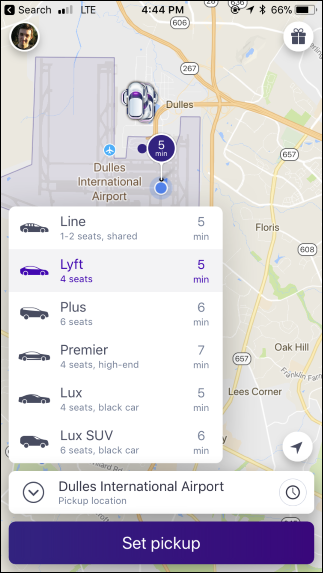Quick Links
Uber and Lyft are two very similar services. Both are "ride-sharing" apps you pull up on your phone to quickly get a ride somewhere from driver using their own car. These two services have become more and more similar over the years, but there are still some major differences between them.
How Uber and Lyft Work
These ride-sharing services work in basically the same way. They allow drivers, who are independent contractors and not employees of Uber or Lyft, to pick you up when you book a ride in the app. You're charged a standard fee with a base rate and a per-minute and per-mile fee. The cost generally adds up to much less than you'd spend on a traditional taxi for the same distance.
That's not the only reason people prefer them to taxis. You can book them from your phone and see exactly where the driver is and when they're arriving, which beats calling a taxi service and wondering when the taxi might arrive. The same app works in every city, or at least the cities where these services are available. Both apps allow you to select a pickup and drop-off location, see nearby cars, and track the car's location as it arrives. At the end of the ride, both let you rate your driver and even tip them from the app, if you like. Drivers rate riders on both services, too.
For the standard service---known as an "uberX" in Uber or just a "Lyft" in Lyft---the experience is about the same. Both allow you to book a larger SUV if you have more people or larger items that need transportation, a higher-end luxury car if you want that experience, or a cheaper shared service known as "uberPOOL" or "Lyft Line" where you'll ride with other people going in the same general direction for a small discount.
Uber and Lyft Are More Similar Than They Used to Be
Lyft has cultivated a more playful, driver-friendly image. Lyft drivers used to have a pink mustache affixed to the front of their car, and fist-bumped their passengers (though they don't do either of those things anymore). Uber acquired a take-no-prisoners, combative reputation for the way it expanded into cities that had regulations on the books that would prohibit it, fighting legal and political battles only after launching the service in a city.
At this point, though, Uber and Lyft are more similar than they are different. In our experience, you'll often call an Uber or Lyft and get in a car only to see that the same driver is driving for both companies. One driver that only drove for Lyft told us that this is typical of drivers who are driving full time, while others (perhaps retirees looking for a bit of extra work) often stick with one service.
Both Uber and Lyft screen their drivers in basically the same way. Anyone can apply to be a driver, and Uber and Lyft both perform background checks with the driver's social security number before approving them. Uber and Lyft use different background check companies, but the criteria for approval can vary based on the state. Lyft re-runs its background checks annually, while Uber doesn't. According to CNN, it's not uncommon for a driver to be approved on one platform but not another. Both Uber and Lyft have encountered cases where a driver was approved when they shouldn't have been, so it's tough to say if one company's background check process is really any better.
They Cost About the Same
There isn't much of a price difference between the two services, in our experience. Competition has driven Lyft and Uber prices down to be largely the same in many areas. There may be a price difference in certain cities, but you can check if yourself using some online tools. Use the Uber Fare Estimate and Lyft Fare Estimate tools for your city (or a city you're visiting) and plug the same pickup and drop-off addresses into both to compare prices.
For example, a ride from the Portland International Airport in Portland, Oregon to the Portland Art Museum downtown is estimated to cost $25-32 with an uberX, and $27 with a standard Lyft. If you click the details, you'll see that Uber and Lyft both charge $0.20 per minute and $1.21 per mile in this city. These are just estimates, and the actual fee will vary depending on whether there's traffic that makes the trip slower.
Both services charge more during peak, high-demand times. Uber calls this "surge pricing" and Lyft calls it "Prime Time". This is designed to encourage drivers to get on the road to perform more pickups at times when there are a lot of people who need rides.
Uber Is More Widespread Than Lyft
While these services are largely similar, there's one big difference. Uber is available in 84 countries around the globe, while Lyft is mostly only been available in the USA. As of the end of 2017, Lyft has just launched in Toronto, Canada, its first city outside the USA. If you're traveling internationally or live outside the USA, plan on using Uber instead of Lyft.
While Uber and Lyft are available in many (but not all) cities throughout the US, there may be gaps in drive availability. While a large city like San Francisco has a lot of drivers for both Uber and Lyft, smaller cities frequently have more Uber drivers than Lyft drivers, at least in our experience. Uber is still the bigger name here, and it can show.
If you like Lyft, don't let this sway you from giving it a try. But you may want to have both the Uber and Lyft apps installed, so you can call an Uber if you find yourself somewhere where there aren't many Lyfts available.
Both Uber and Lyft offer a more expensive service with high-end black cars and professional drivers. Uber has UberBLACK, while Lyft has Lyft Premier, Lyft Lux, and Lyft SUV. But, again, Uber was the first to launch this level of service. You may encounter cities where UberBLACK is available, but the Lyft luxury car services aren't.
The Elephant in the Room: Uber's Bad Behavior
It's impossible to compare Uber and Lyft without talking about Uber's bad reputation. This isn't just talk about Uber's internal culture or its violation of laws that seem designed to protect the taxi industry, either. In October 2016, hackers stole the personal information of some 57 million people from Uber's servers. 50 million riders had their names, email addresses, and phone numbers stolen. That's not too much information if you're just a rider. But 7 million drivers also had their information accessed, and the attackers acquired 600,000 driver's license numbers.
Rather than responsibly disclose the hack, Uber paid the hackers $100,000 to delete the data and hid this attack for more than a year, in apparent violation of the law. Uber's new CEO Dara Khosrowshahi, who took over in September 2017, told Bloomberg that "None of this should have happened, and I will not make excuses for it." He also said that Uber is "changing the way we do business.”
While Uber has been attempting to improve its image and culture recently, it's no surprise that many people have shunned Uber for Lyft given consumer-hostile behavior like that. This may explain why Lyft is now growing faster than Uber. In cities with excellent Lyft coverage, that may be enough to motivate you to choose Lyft over Uber.
However, it's worth noting that many of the things Uber is criticized for are things Lyft also does. Both services use independent contractors instead of employees, pay their drivers about the same, and have a version of "surge pricing" that charges more during busy times. Both services are working on self-driving cars to one day replace those drivers, too.
Image Credit: LeStudio/Shutterstock.com





